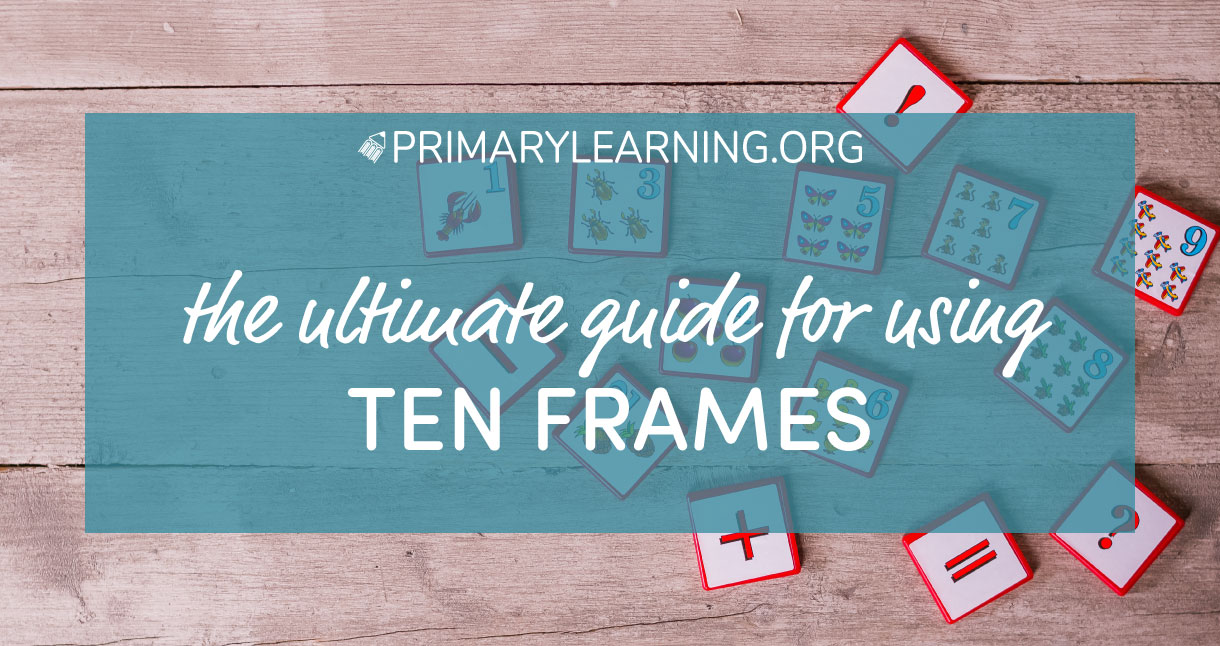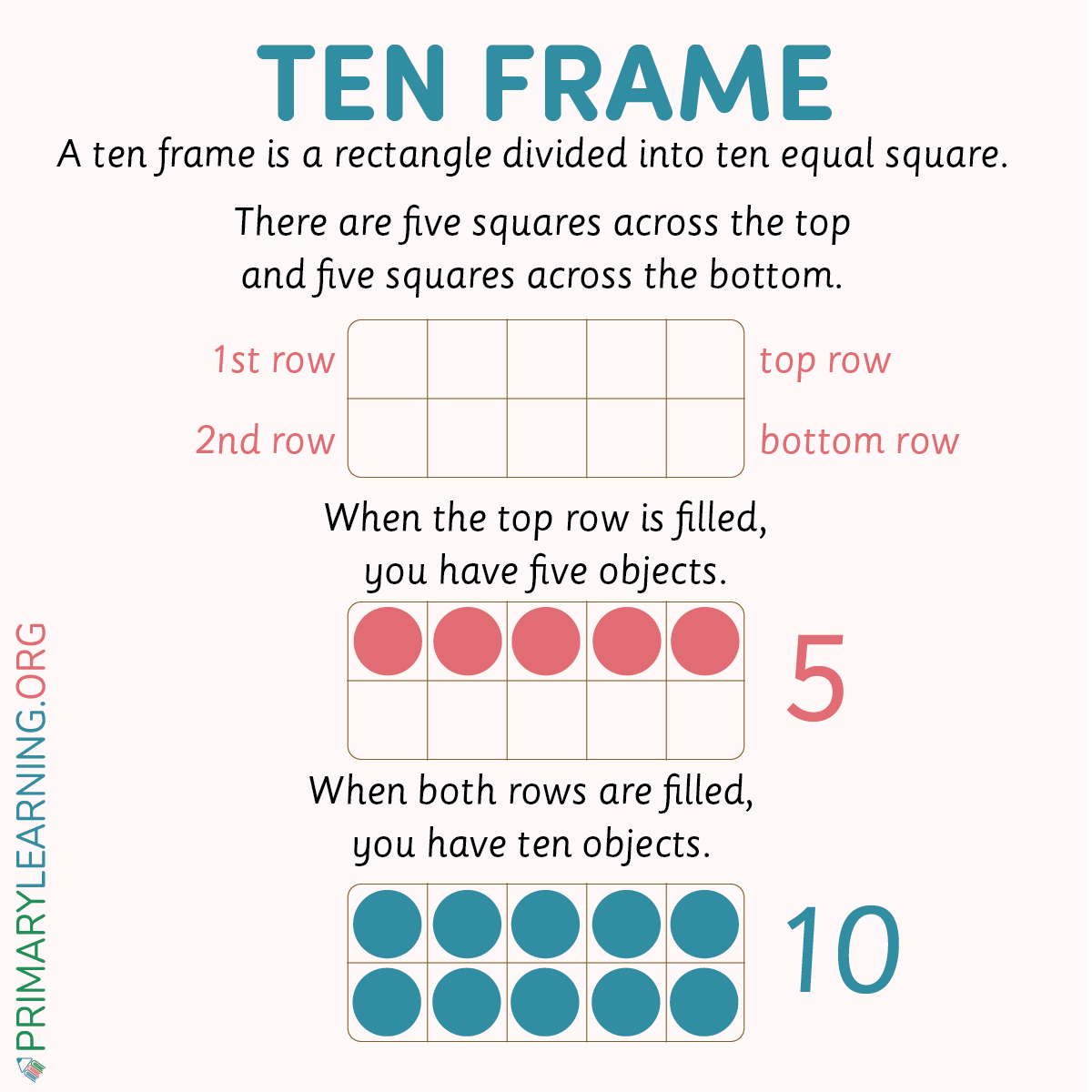

Posted by: Alesia Netuk
Updated: October 3rd, 2023
What You Should Know About Ten Frames
What You Should Know About Ten Frames
A ten frame is an instructional tool used to support learning in math. They provide children with opportunities to learn about numbers both visually and kinesthetically. Ten frames help children develop number sense, which is an understanding of numbers and their relationships.
What is a Ten Frame?
A ten frame is a rectangle divided into ten equal squares. There are five squares across the top and five squares across the bottom. Counters or other markers are placed in the squares to represent numbers of ten or less.
For example, placing three counters in the top row represents the number three. Placing five counters in the top row and two in the bottom row represents the number seven.
Ten frames can be made simply from paper or may be printed on a heavier cardstock and laminated for durability. Various items can be used to represent numbers, such as plastic chips, counters, or gems. Ten frames can also be used on electronic devices such as tablets and laptops.
Applications allow children to move virtual counters into the ten frame boxes using a touch screen, mouse, or tracking pad.
You can also make large ten frames on the floor. Just use tape to create your ten frames then provide children with objects such as frisbees or toys to use as counters.

Why are Ten Frames Important?
Ten frames provide children with a visual representation of numbers and their relationships beyond just the written numerals. Children may learn that five is represented by the numeral “5,” but this does not give them any information about what five truly means. Using a ten frame allows them to see that the number five consists of five items. It assigns value to the number.
Ten frames are also important for children who benefit from using concrete materials to learn. Using manipulatives can be very valuable when teaching math concepts. The movement of counters in and out of ten frames can help children understand these concepts. Manipulatives are often an effective precursor to using numbers.
Using Ten Frames for Counting
Ten frames are versatile tools that can be used to teach a range of mathematical concepts. One of their simple uses is to teach children how to count to ten. In addition to learning rote numbers, children can attach meaning to each number by seeing what it represents. For example, placing seven counters in the boxes allows children to see what “seven” looks like. The ten frame can also be used to recognize that eight is more than seven, and six is less than seven.
Using ten frames to teach number sense:
Count and Write – Part 5
In this worksheet, students count dots in a ten frame and write the correct number word. Great for practice number sense skills.
Count and Write – Part 5
Count and Write – Part 6
In this worksheet, students count dots in a ten frame and write the correct number word. Great for practice number sense skills.
Count and Write – Part 6
Comparing Numbers with Ten Frames
With this worksheet, students count and compare two sets of ten frames. Students cut out statements below and place the one that makes sense.
Comparing Numbers with Ten Frames
Count and Compare – Part 5
With this worksheet, students count and compare two ten frames. Students write a number beside each ten frame and color the one that has the greater number.
Count and Compare – Part 5
Ten frames can support children as they develop one-to-one correspondence. This is an important skill in both math and literacy. In math, one-to-one correspondence is the ability to accurately count items in a set. Each item is counted and is counted only once. Children can practice one-to-one correspondence using ten frames by moving a counter into each box as they say the name of the number. They can also learn about cardinality, which is understanding that the last number said when counting a set of objects is the total quantity of objects.
Using ten frames in kindergarten to learn counting:
Summer: All About Number 0 Worksheet
With this summer-themed worksheet, kids practice all about number 0! Kids count, shade, trace the number zero, and write the number that comes after zero.
Summer: All About Number 0 Worksheet
Summer: All About Number 1 Worksheet
With this summer-themed worksheet, kids practice all about number 1! Kids count, shade, trace the number 1, and write the number that comes after before and after one.
Summer: All About Number 1 Worksheet
Summer: All About Number 2 Worksheet
With this summer-themed worksheet, kids practice all about number 2! Kids count, shade, trace the number two, and write the number that comes after before and after two.
Summer: All About Number 2 Worksheet
Summer: All About Number 3 Worksheet
With this summer-themed worksheet, kids practice all about number 3! Kids count, shade, trace the number three, and write the number that comes after before and after three.
Summer: All About Number 3 Worksheet
Summer: All About Number 4 Worksheet
With this summer-themed worksheet, kids practice all about number 4! Kids count, shade, trace the number four, and write the number that comes after before and after four.
Summer: All About Number 4 Worksheet
Summer: All About Number 5 Worksheet
With this summer-themed worksheet, kids practice all about number 5! Kids count, shade, trace the number five, and write the number that comes after before and after five.
Summer: All About Number 5 Worksheet
Summer: All About Number 6 Worksheet
With this summer-themed worksheet, kids practice all about number 6! Kids count, shade, trace the number six, and write the number that comes after before and after six.
Summer: All About Number 6 Worksheet
Summer: All About Number 7 Worksheet
With this summer-themed worksheet, kids practice all about number 7! Kids count, shade, trace the number seven, and write the number that comes after before and after seven.
Summer: All About Number 7 Worksheet
Summer: All About Number 8 Worksheet
With this summer-themed worksheet, kids practice all about number 8! Kids count, shade, trace the number eight, and write the number that comes after before and after eight.
Summer: All About Number 8 Worksheet
Summer: All About Number 9 Worksheet
With this summer-themed worksheet, kids practice all about number 9! Kids count, shade, trace the number nine, and write the number that comes after before and after nine.
Summer: All About Number 9 Worksheet
Subitizing is another skill that can be practiced using ten frames. Subitizing is the ability to identify the number of items in a set without having to count each item. Imagine rolling dice and recognizing what number comes up without having to count each dot on the dice individually. That’s subitizing. Use ten frames to help children develop this skill by using counters to represent various numbers. The goal is for them to automatically identify numbers without individually counting each counter. For example, when they see a full ten frame, they should know it represents the number ten.
Math center – ten frame activities ideas for hands-on learning:
Math Center – Learning Numbers 1 10
In this math activity, students practice counting and number sense skills. This activity is a great addition to your math centers.
Math Center – Learning Numbers 1 10
Math Center – 10 Frame
With this hands-on math activity, students strengthen number sense skills. Students place the number card below the wagon and the same amount of playdough balls on the wagon.
Math Center – 10 Frame
Using Ten Frames for Addition and Subtraction
Ten frames provide children with a visual and kinesthetic way to understand adding and subtracting. Start simply by having them place one counter in a box and identifying how many counters there are. Next, have them place another counter in a box and identify how many total counters there are now. Introduce language like, “One plus one made two.” Continue allowing them to practise various combinations of counters up to a total of ten. As children become proficient with adding groups of counters together and using mathematical language to describe them, introduce the numerals to create their addition sentences. (e.g., 1+1=2)
Similar to adding, ten frames can be used to help children understand the concept of subtraction. Have them begin by placing a small number of counters in the boxes and identifying how many there are. Next, have them take one counter away then identify how many counters are left. As they experiment with different combinations, introduce language such as, “Three counters take away one counter leaves two.” Once they solidify this concept, introduce them to numerals to create subtraction sentences. (e.g., 3-1=2)
As children gain proficiency using their ten frames to add and subtract, you can begin presenting them with math questions to answer. For example, provide them with the question “3+4=” and have them use their ten frames to find the answer.
Solving word problems using ten frames:
Subtraction Word Problem #1
This word problem worksheet helps kindergarteners solve a number problem using different methods – draw a picture, ten frame, and number line.
Subtraction Word Problem #1
Subtraction Word Problem #2
This word problem worksheet helps kindergarteners solve a number problem using different methods – draw a picture, ten frame, and number line.
Subtraction Word Problem #2
Subtraction Word Problem #3
This word problem worksheet helps kindergarteners solve a number problem using different methods – draw a picture, ten frame, and number line.
Subtraction Word Problem #3
Subtraction Word Problem #4
This word problem worksheet helps kindergarteners solve a number problem using different methods – draw a picture, ten frame, and number line.
Subtraction Word Problem #4
Addition Word Problem #2
This word problem worksheet helps kindergarteners solve a number problem using different methods – draw a picture, ten frame, and number line.
Addition Word Problem #2
Addition Word Problem #3
This word problem worksheet helps kindergarteners solve a number problem using different methods – draw a picture, ten frame, and number line.
Addition Word Problem #3
Addition Word Problem #4
This word problem worksheet helps kindergarteners solve a number problem using different methods – draw a picture, ten frame, and number line.
Addition Word Problem #4
When children are ready to move beyond numbers to ten, they can use two ten frames to explore numbers up to 20. For example, place seven counters in a ten frame and nine counters in a second ten frame then have children add them together to discover that 7+9=16. They can also explore subtraction using two ten frames.
Ten frames are versatile tools to help children learn a variety of math concepts focused on numbers. Consider incorporating them into your program to support your visual and kinesthetic learners.
References
See the research that supports ten frame strategy: It Makes Sense! Using Ten-frames to Build Number Sense, Grades K-2 by Melissa Conklin
LEARNING MATERIALS TO MEET EVERY CHILD’S NEEDS
Here, at PrimaryLearning.Org, we tend to deliver the best-differentiated learning materials to K-2 students. Our resources can be easily incorporated into multisensory lessons to meet every child’s needs, whether s/he is a visual, kinesthetic, or auditory learner.